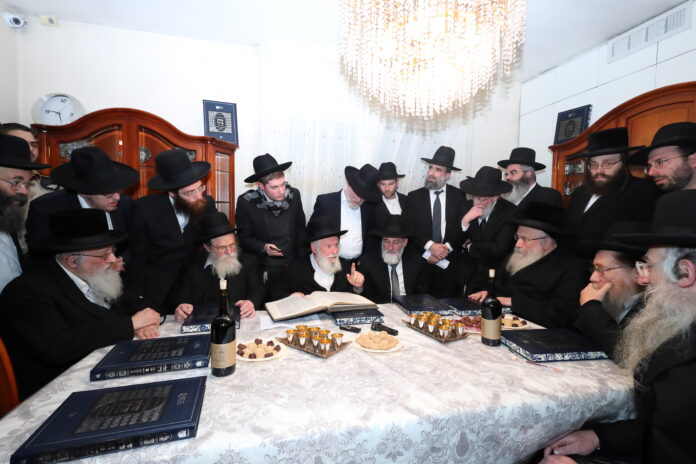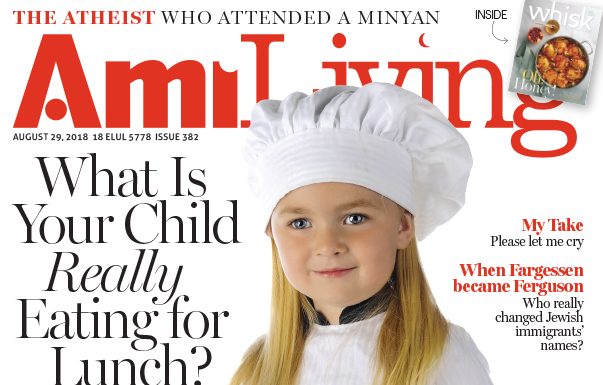Last week, a special gathering took place in the home of Rav Yitzchok Zilberstein to mark a special occasion: the publication of Dirshu’s edition of the Shulchan Aruch. At the start of the gathering, Rav Zilberstein said, “The greatest thing in klal Yisrael is one who causes others to learn Torah.”
Seated with Rav Zilberstein were Bnei Brak rabbanim Rav Masoud Ben Shimon, Rav Moshe Shaul Klein, Rav Sariel Rosenberg, Rav Shevach Tzvi Rosenblatt, Rav Yaakov Meir Stern and Rav Shmuel Eliezer Stern, as well as Rav Dovid Hofstedter, the nasi of Dirshu.
Also present at the gathering were the many rabbanim and yungeleit who were involved in the editing and publication of this new edition. On the table were some volumes from this first printing, and those present took the opportunity to examine them.
Addressing the crowd, Rav Zilberstein opened his gemara to Gittin 61a and shared the following: “Rav Kahana said of a person who showed a particular bekius in halachah, ‘You must be from Rav Yoshiyah’s town,’ which is why he was so proficient in halachah. Rav Kahana then said of Rav Yoshiyah, ‘About him the pasuk says, “V’tzaddik yesod olam—a tzaddik is the foundation of the world.”’ Rashi explains that Rav Kahana knew that this man was proficient in halachah because he was from Rav Yoshiyah’s town, as Rav Yoshiyah would teach the public and make sure they knew the halachos.
“I have never seen anything like this elsewhere! These aren’t witticisms. The world stands upon certain foundations, and who are those foundations? Those who teach halachos to the public. Standing next to me is this tzaddik,” Rav Zilberstein said, pointing at Rav Hofstedter. “Pardon me for talking about you, but this is a person who has merited to spread the knowledge of halachah among am Yisrael. The Gemara doesn’t employ exaggeration, and it states that one who spreads the knowledge of halachos is referred to as tzaddik yesod olam.”
Rav Zilberstein then turned a few pages back and read aloud another passage (58a): “Rabbi Yehoshua ben Chananyah once went to the metropolis of Rome, where he was told that a Jewish child was in prison. He went to the door of the prison and called out, ‘Mi nasan limshisah Yaakov v’Yisrael l’vozezim—Who delivered Yaakov for plunder and Yisrael to the robbers?’ (Yeshayahu 42:24). The child replied with the rest of the pasuk, ‘Halo Hashem, zu chatanu lo v’lo avu vidrachav haloch v’lo sham’u b’Soraso—Was it not Hashem, against Whom we sinned? For they did not want to walk in His ways, and they did not listen to His Torah.”’ Rabbi Yehoshua said, ‘I am certain that he will be a moreh horaah for klal Yisrael.’
“When discussing this Gemara, my father-in-law Rav Elyashiv told me that this is the highest level possible: a child who will be a moreh horaah for klal Yisrael. Dirshu has already furthered this through its edition of the Mishnah Berurah, and now it is continuing with this new edition of the Shulchan Aruch. What is the greatest level of Torah? ‘I am certain that he will be a moreh horaah,’ and that is exactly what Dirshu is doing.”
Next to speak was Rabbi Binyomin Birenzweig, editor-in-chief of the Dirshu Shulchan Aruch. “We are meriting to see the glorification of Torah in a magnificent vessel,” he said. “We worked for years to find the right formula so that every single person would be able to find a geshmak in learning halachah. A significant portion of the success belongs to all of the editors who are here today, who include a number of rabbanim who are devoted to their kehillos yet found the time to take part in teaching halachah to klal Yisrael.
“The Gemara says (Brachos 8a), ‘Miyom shecharav Beis Hamikdash ein lo l’Hakadosh Baruch Hווu b’olamo ela arba amos shel halachah—From the day the Beis Hamikdash was destroyed, the only thing Hakadosh Baruch Hu has in His world is the four cubits of halachah.’ The Maharsha explains that in the times of the Beis Hamikdash, the horaah would go out to the entire nation from the lishkas hagazis [because that was the office of the Sanhedrin]. Nowadays, when we don’t have the Beis Hamikdash, ‘those four amos of halachah, which each talmid chacham creates by learning, stands in the stead of the lishkas hagazis and draws down the Shechinah.’ We see from here that the more study of halachos we have, the greater is the Shechinah’s presence.
“Rav Dovid Hofstedter has merited to do this in unprecedented ways by bringing halachah to so many people through the Dirshu Mishnah Berurah, and now he is doing it again through this Shulchan Aruch. Rav Dovid has been involved every step of the way, guiding us on how to put it together so it will surely increase the Shechinah’s presence.”
He was followed by Rav Dovid Hofstedter. “This is a very emotional time,” he began. “This edition of the Shulchan Aruch has been published after much thought and many nisyonos. Three years ago, the entire world was locked down, and we had to pause our work on it. But baruch Hashem, Hakadosh Baruch Hu gave us the siyata dishmaya to produce it. On the words, ‘V’eileh hamishpatim asher tasim lifneihem,’ Rashi says, ‘Don’t think that you will repeat the words to them over and over again until they are fluent without understanding their meaning. Rather, it must be spread out before them like a set table.’ We think of the Shulchan Aruch as a kitzur of the halachos, but the real meaning of a shulchan aruch—a set table—is that it must include all of the reasons. Don’t think that it is possible to learn Shulchan Aruch without them. Its true study is in depth. In our generation, how can one learn Yoreh Dei’ah without that which has been given to us by the poskim of our times?
“Rav Zilberstein mentioned Rav Elyashiv, who accompanied us on many of our projects on halachah, such as Kinyan Halachah and Daf Yomi B’halachah. Similarly, Dirshu’s Shulchan Aruch, whose publication we are celebrating tonight, was produced according to the guidance of the gedolim. Yasher koach from the depths of our hearts to the poskim and gedolim who guide us and give us chizzuk.”
To read more, subscribe to Ami





















